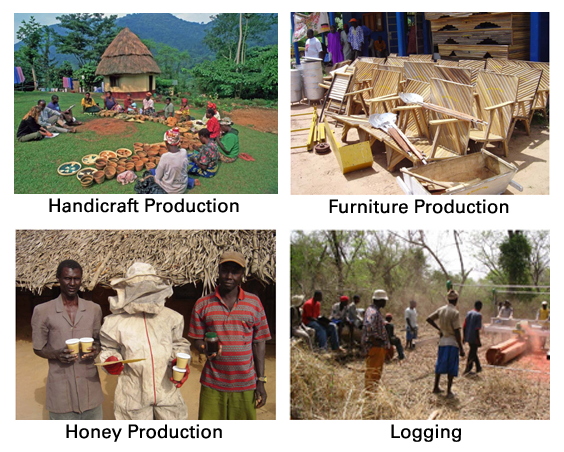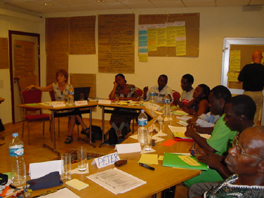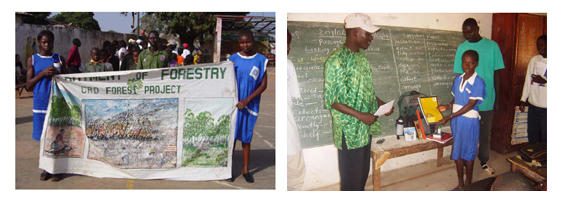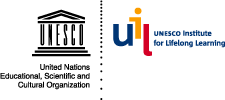Community-Based Forestry Management Programme
Country Profile: Gambia
| Population | 1,660,000 (2011 estimate) |
|---|---|
| Poverty (Population living on less than US$1 per day) | 58% |
| Official Language | English |
| Other recognised languages | Mandinka, Bambara, Wolof, Pulaar, Soninké and Jola |
| Total Expenditure on Education as % of GNP | 2.8 |
| Primary School Net Enrolment/Attendance | 62% |
| Sources |
Programme Overview
| Programme Title | Community-Based Forestry Management Programme (CBFMP) |
|---|---|
| Implementing Organization | The government of the Gambia (through the Forestry Department) in partnership with local NGOs such as the National Consultancy on Forestry Extension Services and Training (NACO), Fight Against Social and Economic Exclusion (FASE), the National Beekeepers’ Association of the Gambia (NBAG) and the Jamorai Timber and Firewood Federation (JATIFIF) |
| Language of Instruction | English and African languages (e.g. Mandinka, Bambara, Wolof, Pulaar, Soninké and Jola) |
| Funding | The government of the Gambia; the Food and Agriculture Organization of the United Nations (FAO) and the government of Germany through the Gambian-German Forestry Project (GGFP) |
| Date of Inception | 2001 – (ongoing) |
Context and Background
The Republic of the Gambia is one of the least developed and poorest countries in Africa, with an economy that is heavily dependent on agriculture and the processing of agricultural products. The agricultural sector accounts for about 30 % of the Gross Domestic Product (GDP) and employs over 70 % of the total labour force. The heavy dependence on agriculture has impeded the country’s development and thus the state’s capacity to provide its people with basic amenities including access to alternative livelihood and educational opportunities. As a result, about 58 % of the population live in absolute poverty (i.e. on less than US$1 per day) and about 36 % and 55 % of the youth and adult population, respectively, are illiterate. In addition, heavy dependence on subsistence farming has also led to massive deforestation and environmental degradation, an aspect which has increased poverty levels in rural areas where about 63 % of the country’s population reside. Current estimates suggest that 43 % of the total land area in the Gambia is still covered by forests, 78 % of which are severely degraded.
In order to address this situation, the Gambian government, with support from FAO and the German government through the Gambian-German Forestry Project (GGFP) and various local NGOs, has been spearheading the establishment of community forests and community-based forestry projects since the early 1990s. To this end, the government adapted the Community Forestry Concept (developed by FAO, see below) and introduced the Gambian Forest Management Concept (GFMC) through the Gambian Forestry Act (1995). In addition, the state also established the National Forest Fund (NFF, 1996) and the National Forestry Action Plan (NFAP, the latest being for the 2001–2010 period). The principal aim of these policy instruments was to promote development, social empowerment (poverty alleviation) and environmental conservation through participatory or community-based management and exploitation or utilisation of forests and forest resources. It is on the basis of this enabling policy environment that the Gambian government instituted the Community-Based Forestry Management Programme (CBFMP) in 2001.
The Community-Based Forestry Management Programme (CBFMP)
The CBFMP is an integrated life skills and ecological (environmental) management training programme which, as noted above, is based on the GFMC or the Community Forest Concept (CFC).
Aims and Objectives
The CFC and thus the CBFMP is basically a participatory forest management approach the basic aim of which is to transfer forest ownership and user rights from the state to local communities in order to:
- promote literacy development and lifelong learning;
- stimulate collective attitudinal changes towards natural resources in order to promote sustainable environmental conservation;
- assist rural households to achieve sustainable livelihoods (i.e. to increase their income-earning capacity) through skills training in sustainable and community-centred management and utilisation of forestry resources and products;
- promote rural development; social transformation and empowerment by enabling the rural population to own and actively participate in the management and exploitation of community forests, and
- assist rural communities in adapting traditional land use systems according to the recent development of both human and natural resources; and finally
- empower local communities to become effective and environmentally conscious natural resource-based entrepreneurs.
Programme Implementation: Approaches and Methodologies
The GFMC endeavours to promote rural or community development and social empowerment by directly linking forest management and conservation activities to basic life skills training and income-generating opportunities. To this end, the CBFMP is implemented through a holistic and integrated approach which provides participants with training in:
- literacy (basic and functional literacy; continuing education);
- livelihood skills training and support to establish income generation activities / projects (in, for example, handicraft production; beekeeping; cash crop production; sustainable firewood harvesting and timber production);
- civic and health education; and
- environmental management / conservation.

The CBFMP is currently being implemented in three divisions / regions of the country: Western Division, Central River Division and Lower River Division. Currently, over 500 villages or communities are participating in the programme, managing more than 300 Community Forests covering over 24 000 hectares of Gambian forest.
Capacity Building: Recruitment and Training of Facilitators / Trainers

In order to ensure the effective and sustainable implementation of the CBFMP, FAO provides ongoing technical skills training and support in participatory forest management and community-based forest enterprise development strategies to professional personnel from the Department of Forestry and other programme-implementing partners. In addition, field trainers or extension workers from diverse technical fields including agriculture, forestry and education have also been recruited and provided with technical training and support in the implementation of the CBFMP. In general, the Training of Trainers (ToT) programme focuses on the following key areas:
- using participatory methods and tools for selecting viable products for the community-based enterprises;
- conducting analysis based on the four areas of Enterprise Development (Social/ Institutional, Science/Technology, Resource/Environment, Market/Economy);
- conducting surveys (including resource and market surveys) on forest products at district and divisional levels;
- creating interest groups for selected products;
- developing enterprise development plans;
- monitoring the implementation of enterprise plans; and
- linking with appropriate sources of enterprise development support.
The programme partners have also developed a package of educational training materials in local languages for use by field trainers in conducting training activities in the communities. In addition to conducting skills training activities to participating communities, field trainers are also responsible for mobilising communities to participate in the programme as well as for advising participating groups and communities on issues related to general community development, planning and implementation of community-based forest enterprise development projects.
Community Mobilisation
It is of utmost importance that from the very beginning all the stakeholders including local leaders and authorities of a community, such as chiefs, village heads, elders, household heads and women leaders, as well as forest user groups, are actively involved in all phases of the programme implementation. This includes assessing forest conditions and development of options, planning and implementing management activities.
The mobilisation of the communities to participate in the programme is primarily conducted by field extension workers or trainers and community leaders through community-based sensitisation activities and civic education programmes as depicted in the pictures below:

In addition and in order to ensure local ownership of programme activities, programme implementers also assist participating communities in establishing Community Forest Committees (CFCs) or Village Development Committees whose members are elected by the local population. These Committees are trained by project-implementing partners and are, thereafter, entrusted with the overall responsibility of spearheading / planning, coordinating and managing the implementation of the programme at the local level, including the initiation of skills training and natural resource-based income generating activities. The Committees are also responsible for coordinating the recruitment and training of programme facilitators or instructors as well as for mobilising other community members to participate in the programme.
Programme Impact
The programme’s impact can be seen in different realms:
Policy impact:
- The move towards Community Forest (CF) management and sustainable utilisation, as stated in Forest Act, becomes real
- Participation of communities in participatory forest management increases
Social impact
- Increasing the consideration of gender aspects
- Promoting the benefit of working together, benefiting from a synergy of efforts
- Reducing friction between the stakeholders
- Creating more employment opportunities
- Creating a platform for information exchange
Ecological impact
- An increase in consciousness of forest utilisation methods
- An in crease in environmental knowledge and awareness
- A reduction of illegal forest utilisation
Monitoring and Evaluation
The Community Forests management develops a three-year or a five-year management plan based on the forest assessment studies they conduct. The plan is developed by the Communities into a work plan. A copy is sent to the Department of Forestry which would be used as a monitoring and evaluation tool and also a prerequisite for gratis issue of a license for marketing products. A Natural Resource facilitation team is developed in the field which works directly with the Community Forests. The team monitors the farmers’ performance and progress based on their own plans and also assesses the constraints and limitations.
Lessons Learned
Experience demonstrates that the success, effectiveness and sustainability of the CBFMP have largely been a result of:
- the existence of strong working networks between the state, community leaders and local and international NGOs;
- the promotion community ownership of the programme and active participation in programme activities;
- the integration of natural resource conservation activities into income-generating projects; and
- the provision of appropriate and relevant training to all stakeholders (capacity building and skills training).
Sustainability
It can be argued that the long-term sustainability of the CBFMP is assured primarily because the project enjoys the unwavering support of its primary targets and beneficiaries, the rural communities, as well as local and international NGOs. In addition and apart from having assured and long-term funding from international NGOs and the state, the financial sustainability of the programme has also been ensured through the implementation of a benefit sharing scheme. Through this scheme, 15 % of the funds generated by the project go to and are administered by the central government under the National Forest Fund (NFF) while 85 % remain in the communities. The funds that remain in the communities are used to support various community development initiatives, including the building of schools, mosques, seed stores and community centres, and micro-financing of community-based income-generating projects. This financial arrangement has further motivated local communities to support the programme and participate in it. Last but not least, the active involvement and participation of local communities has also been central to the sustainability of the programme.
Sources
- FAO, 2005, Empowering communities through forestry: Community-based enterprise development in the Gambia
- Community-based forest enterprise development in The Gambia
- S. Blaschke, A. Dampha & K Camera, 2005: Empowering communities through forestry: The Market Analysis and Development (MA & D) Experience in the Gambia
- Jammeh, M. L. Participatory forest management in the Gambia
- Camara. H., 2011, "Literacy and Sustainable Economic Growth through Participatory forest management in the Gambia”. Powerpoint Presentation.
Contact:
Mr. Hatab Camara
Market Analysis and Development Coordinator
Department of Forestry
P.O.box 504, Banjul
Phone: +22 06 32 13 31 / +22 03 65 74 15 / +22 04 22 75 37
Fax: +22 04 22 47 65
Email: User: madproservice
Host: (at) yahoo.com / User: sherifo76
Host: (at) gmail.com

